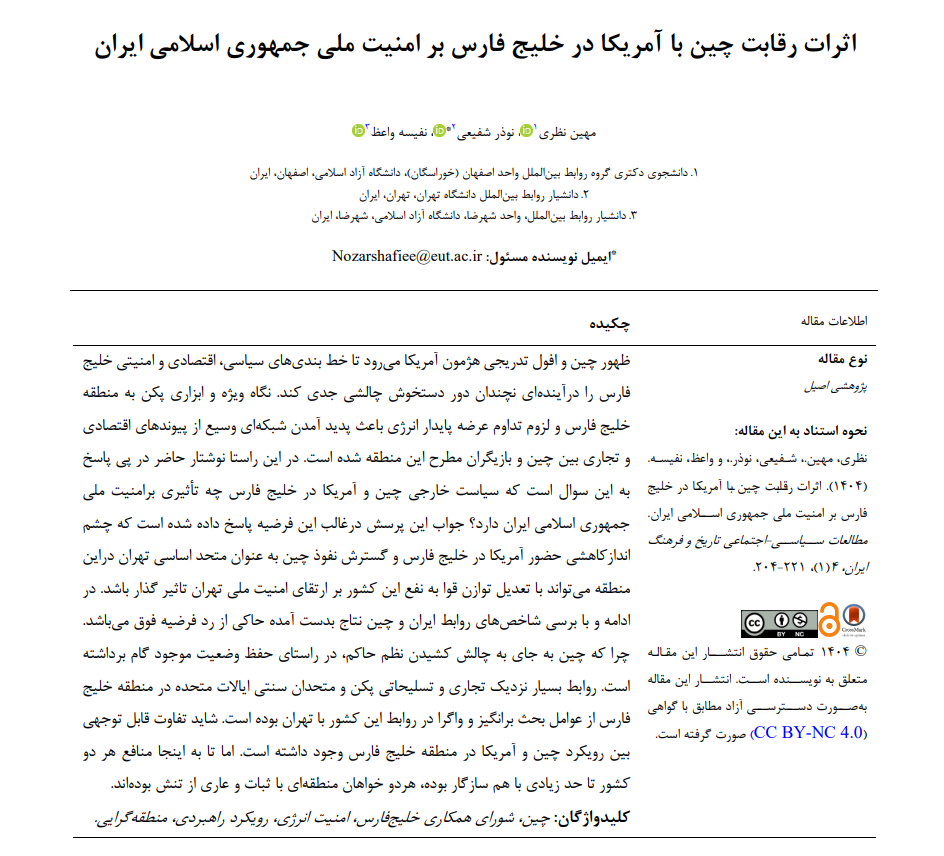The Effects of China–U.S. Competition in the Persian Gulf on the National Security of the Islamic Republic of Iran
Keywords:
China, regionalism, strategic approach , Persian Gulf Cooperation Council, energy securityAbstract
The rise of China and the gradual decline of American hegemony are poised to significantly challenge the existing political, economic, and security alignments of the Persian Gulf in the near future. Beijing's strategic and instrumental focus on the Persian Gulf region, coupled with the necessity of maintaining a stable energy supply, has led to the emergence of an extensive network of economic and trade connections between China and key actors in the region. Accordingly, the present article seeks to answer the following question: What impact does the foreign policy of China and the United States in the Persian Gulf have on the national security of the Islamic Republic of Iran? This question is addressed through the hypothesis that the declining presence of the United States in the Persian Gulf and the expansion of China's influence—as a fundamental ally of Tehran—could, by shifting the regional balance of power in Iran's favor, contribute to the enhancement of Tehran’s national security. However, the analysis of indicators related to Iran–China relations leads to a rejection of this hypothesis. This is because, rather than challenging the existing order, China has acted to preserve the status quo. Beijing’s deep commercial and military ties with the traditional allies of the United States in the Persian Gulf are among the most controversial and divergent factors in its relationship with Tehran. While there may be notable differences between the approaches of China and the United States in the Persian Gulf, their interests have so far largely aligned, with both seeking a stable and tension-free region.
Downloads
References
Behboudinejad, G. (2023). The Persian Gulf between the United States' Indo-Pacific strategy and China's Belt and Road Initiative. Foreign Policy Quarterly, 36(4), 145-174.
Belal, K. (2020). China-Iran Relations: Prospects and Complexities. Policy Perspectives, 17(2), 47-66. https://doi.org/https://doi.org/10.13169/polipers.17.2.0047
Burgess, R. L., Jr. (2010). Statement before the United States Senate Committee on Armed Services on Iran's Military Power. http://www.dia.mil/public-affairs/testimonies/2010-04-13.htm
Clinton, H. (2011). America's Pacific Century. [Link not provided]
Donilon, T. (2011). America is back in the Pacific and will uphold the Rules.
Fulton, J. (2022). China and the Persian Gulf: Hedging Under the U.S. Umbrella. Handbook.
Garlick, J., & Halvova, R. (2020). China's Belt and Road Economic Diplomacy in the Persian Gulf: Strategic Hedging amidst Saudi-Iranian Regional Rivalry. Journal of Current Chinese Affairs, 49(1), 82-105. https://doi.org/https://doi.org/10.1177/1868102619898706
Gillard, M. (2006). Hegemonic Stability theory and the evolution of the space weaponization regime during the cold war Thesis submitted in partial fulfillment of the requirement for the degree of M.A., University of British Columbia].
Holmes, J. R., & Yoshihara, T. (2008). China's Naval Ambitions in the Indian Ocean. Journal of Strategic Studies, 31(3), 360-378. https://doi.org/https://doi.org/10.1080/01402390802024700
Holslag, J. (2009). Embracing Chinese Global Security Ambitions. Washington Quarterly, 32(3), 105-118. https://doi.org/https://doi.org/10.1080/01636600903035373
Kamrava, M. (2018). Troubled Waters: Insecurity in the Persian Gulf. Ithaca, NY: Cornell University Press. https://doi.org/https://doi.org/10.7591/cornell/9781501720352.003.0003
Khan, Z. (2016). China-India Growing Strides for Competing Strategies and Possibility of Conflict in the Asia-Pacific Region. Pacific Focus, 31(2), 232-253. https://doi.org/https://doi.org/10.1111/pafo.12072
Lei, D. (2008). China's New Multi-Faceted Maritime Strategy. Orbis, 52(1), 139-157. https://doi.org/https://doi.org/10.1016/j.orbis.2007.10.009
Medcalf, R. (2015). Reimagining Asia: From Asia Pacific to Indo Pacific.
Sadiq Bat'haei Asl, M., Mirabrahimi, M., & Sabri, M. (2015). Examining the impact of the security presence of the United States and China in the geopolitical domain of the Persian Gulf on the national security of the Islamic Republic of Iran. Cultural and Political Studies of the Persian Gulf, 2(6), 9-35.
Stewart, P. (2019, March 24). With an Eye on Iran, U.S. Clinches Strategic Port Deal with Oman. https://af.reuters.com/article/worldNews/idAFKCN1R50JZ?feedType=RSS&feedName=worldNews
World Bank. (2018). Belt and Road Initiative. [Link not provided]








